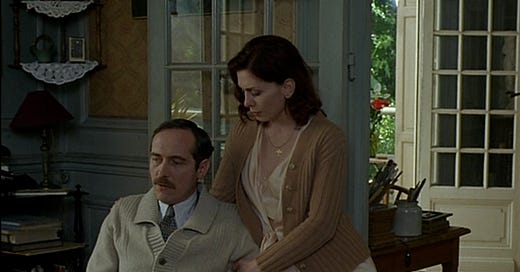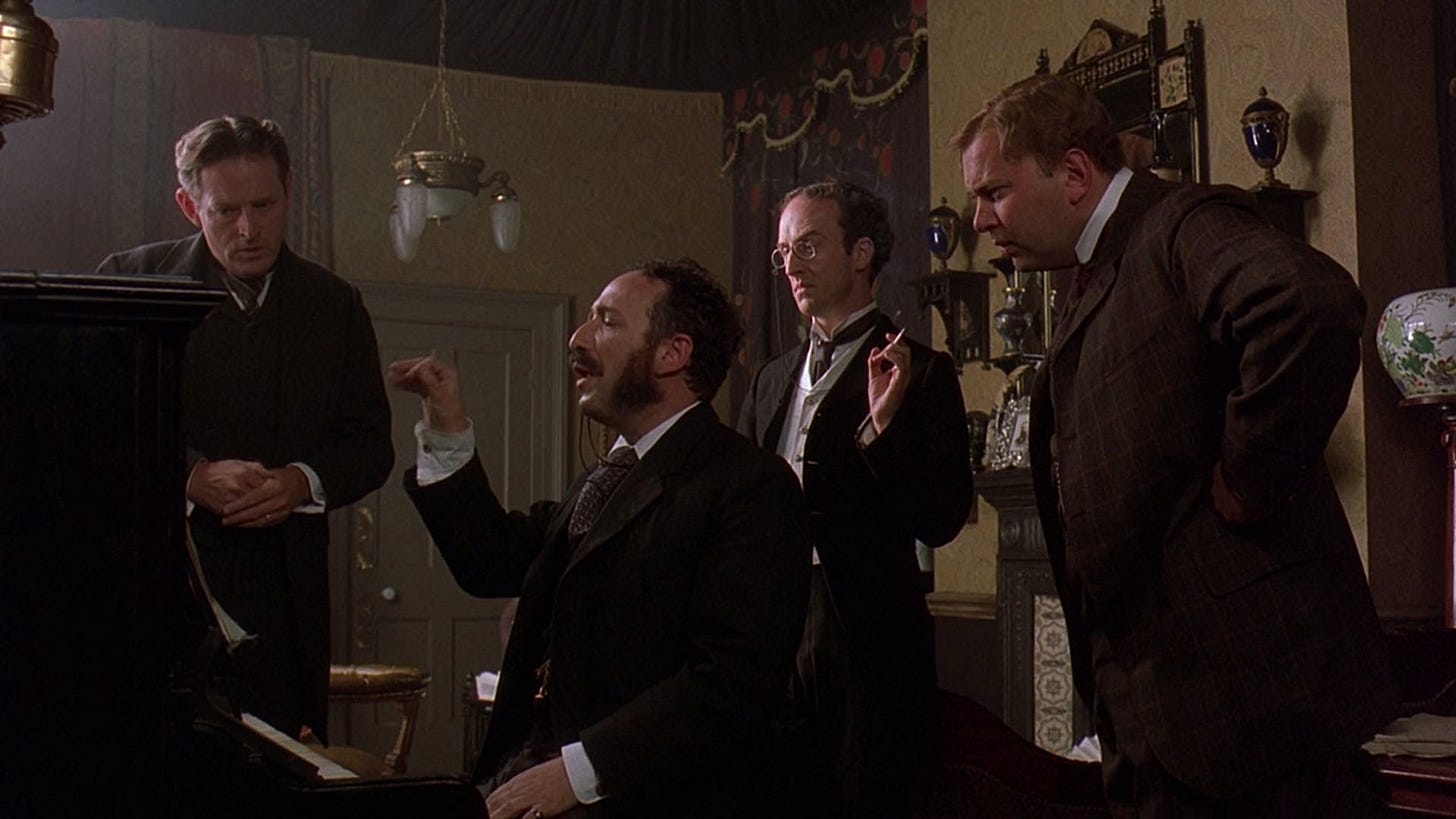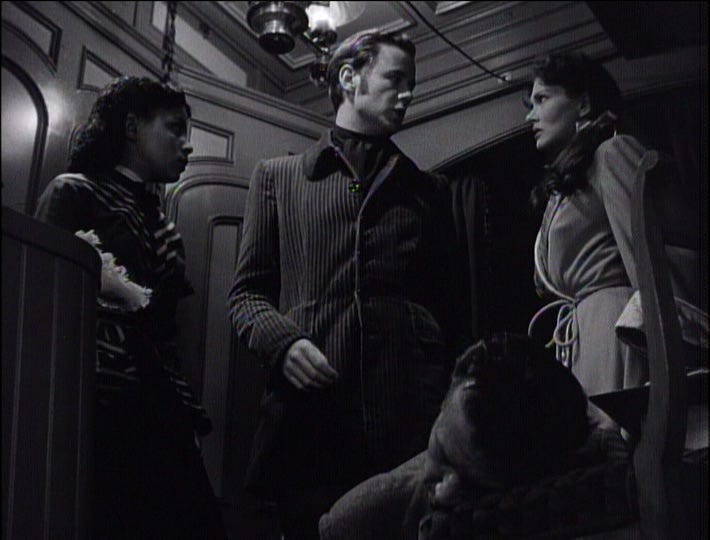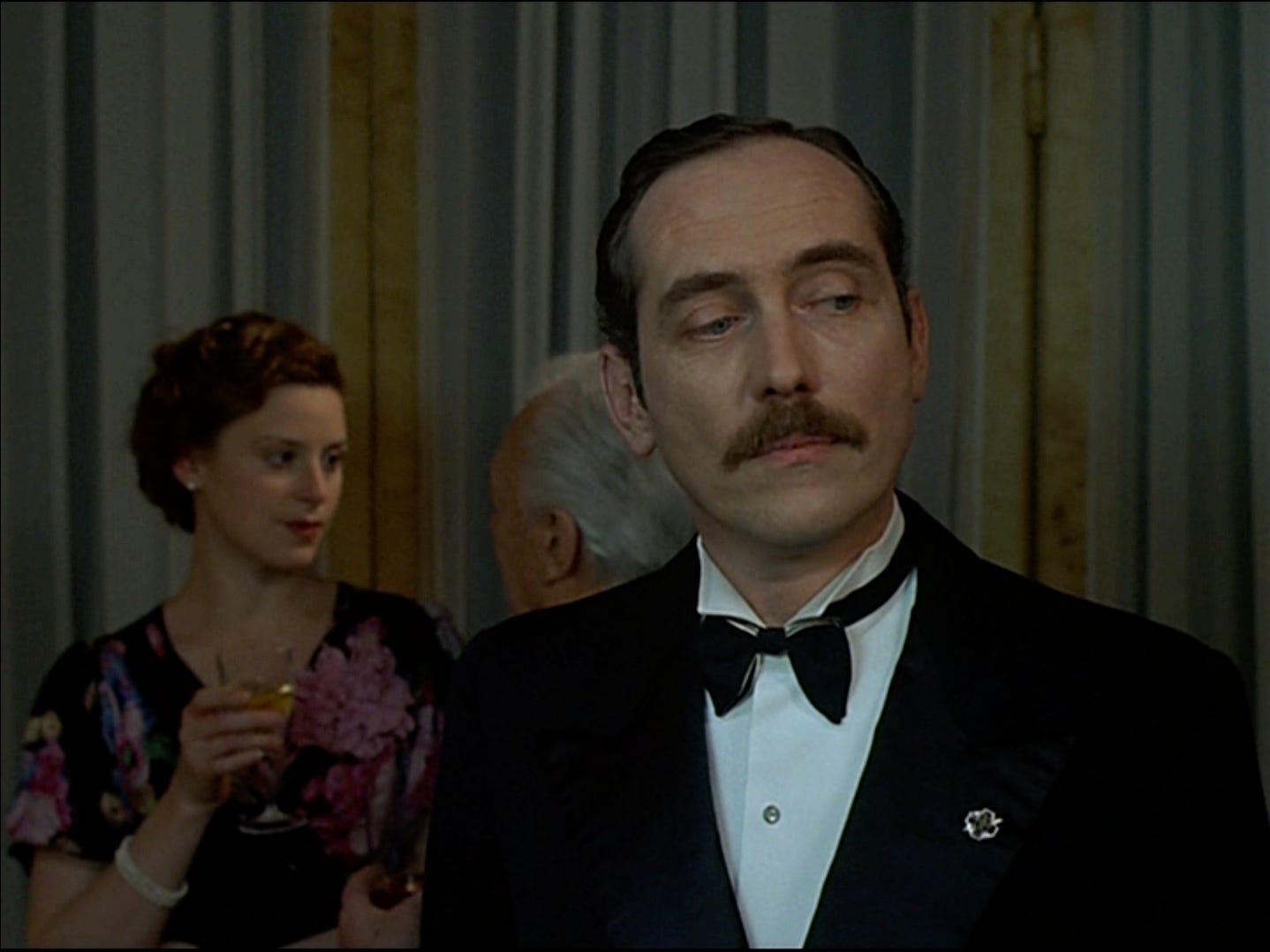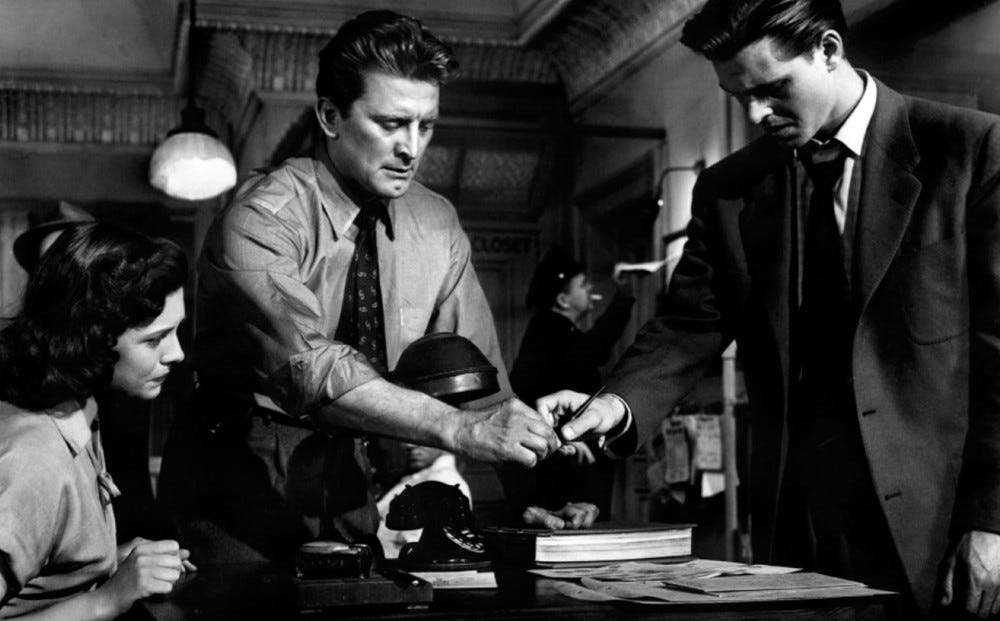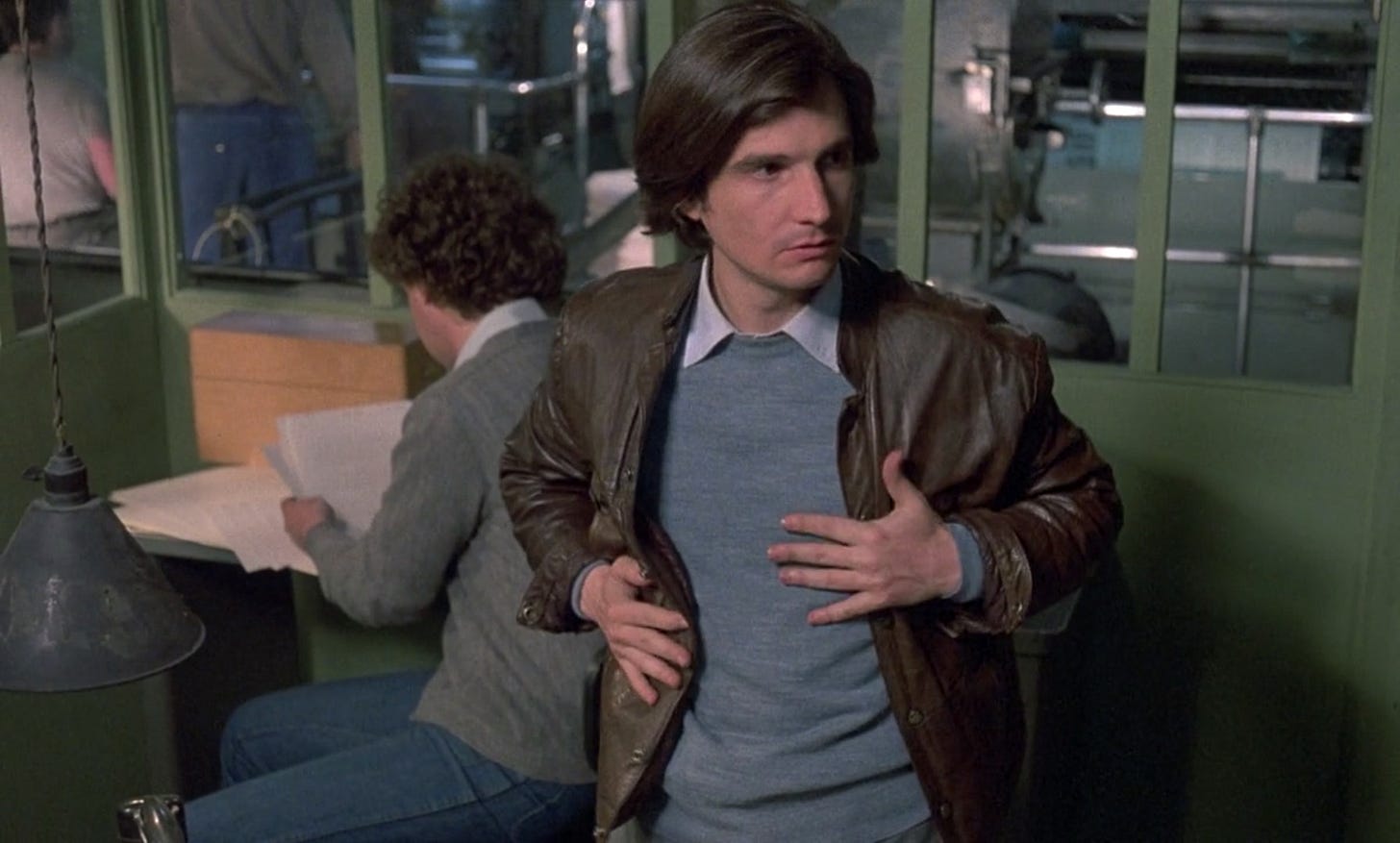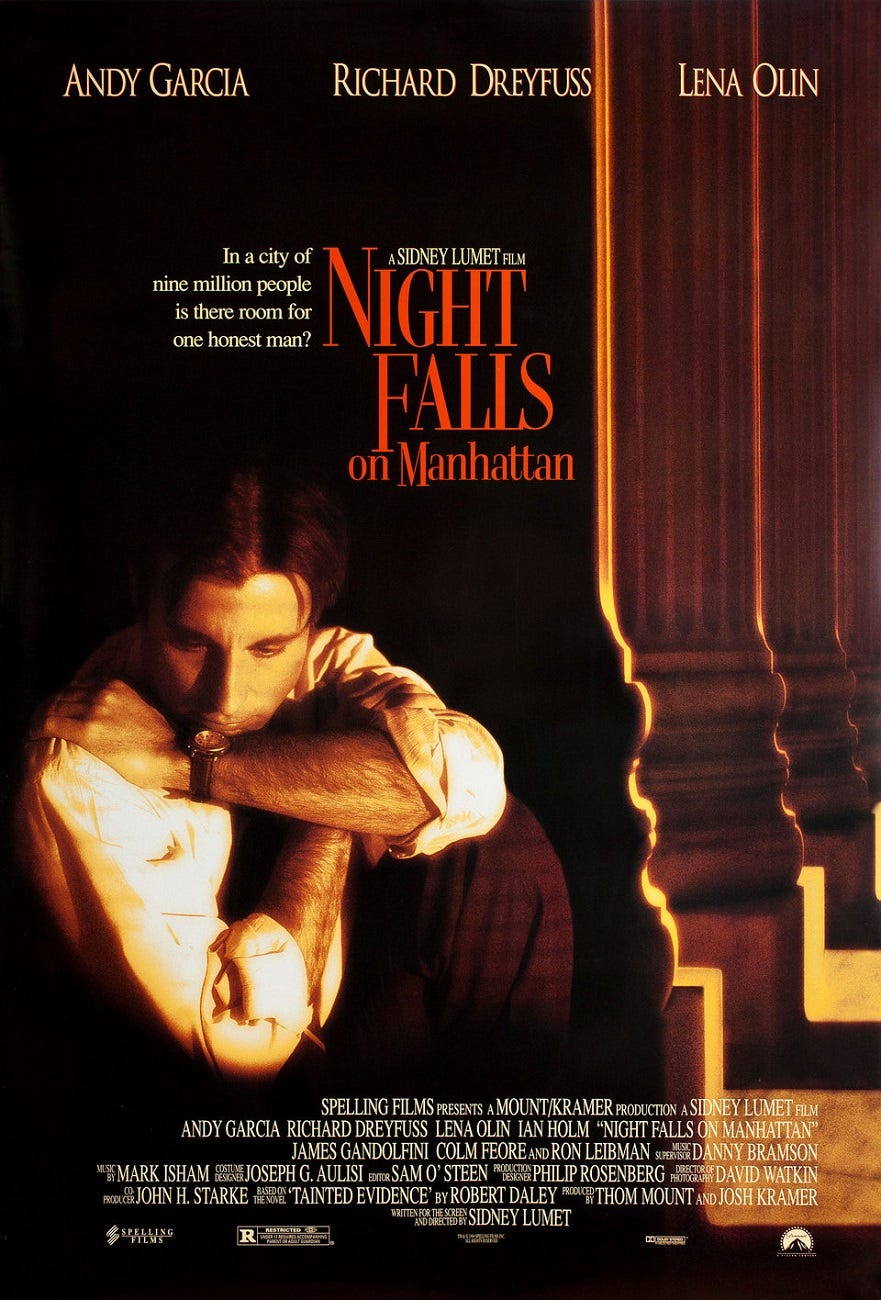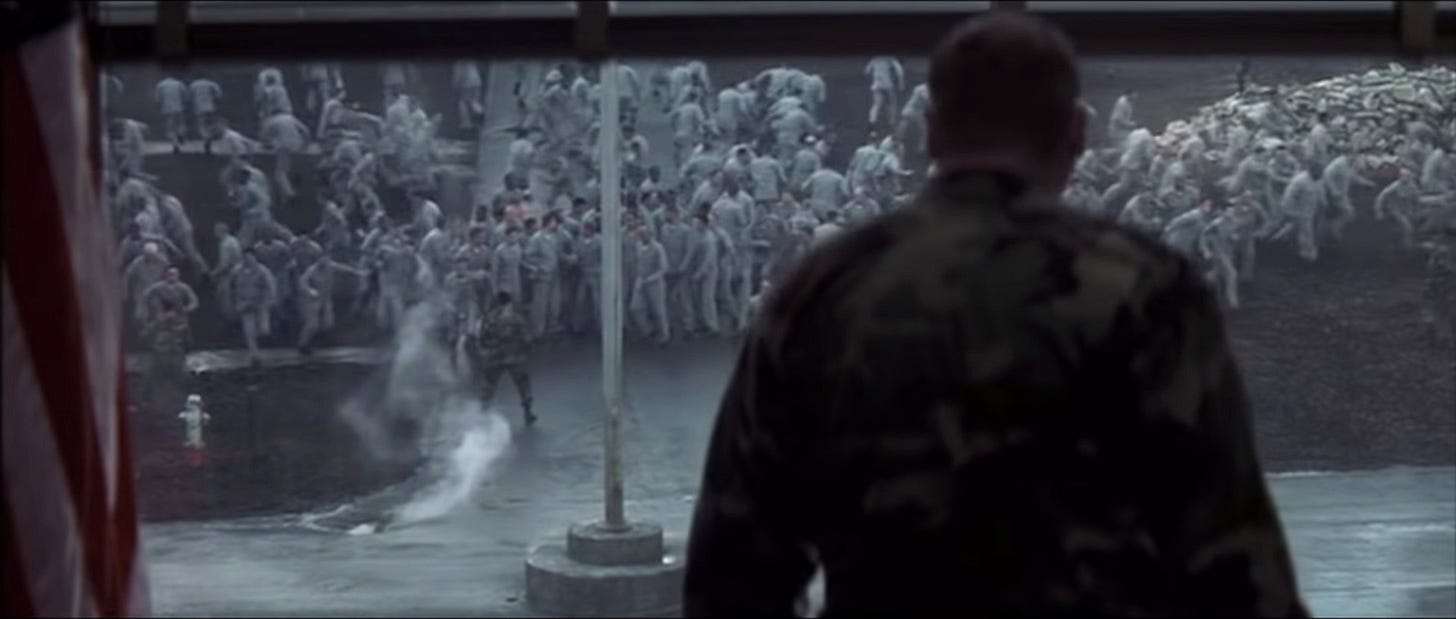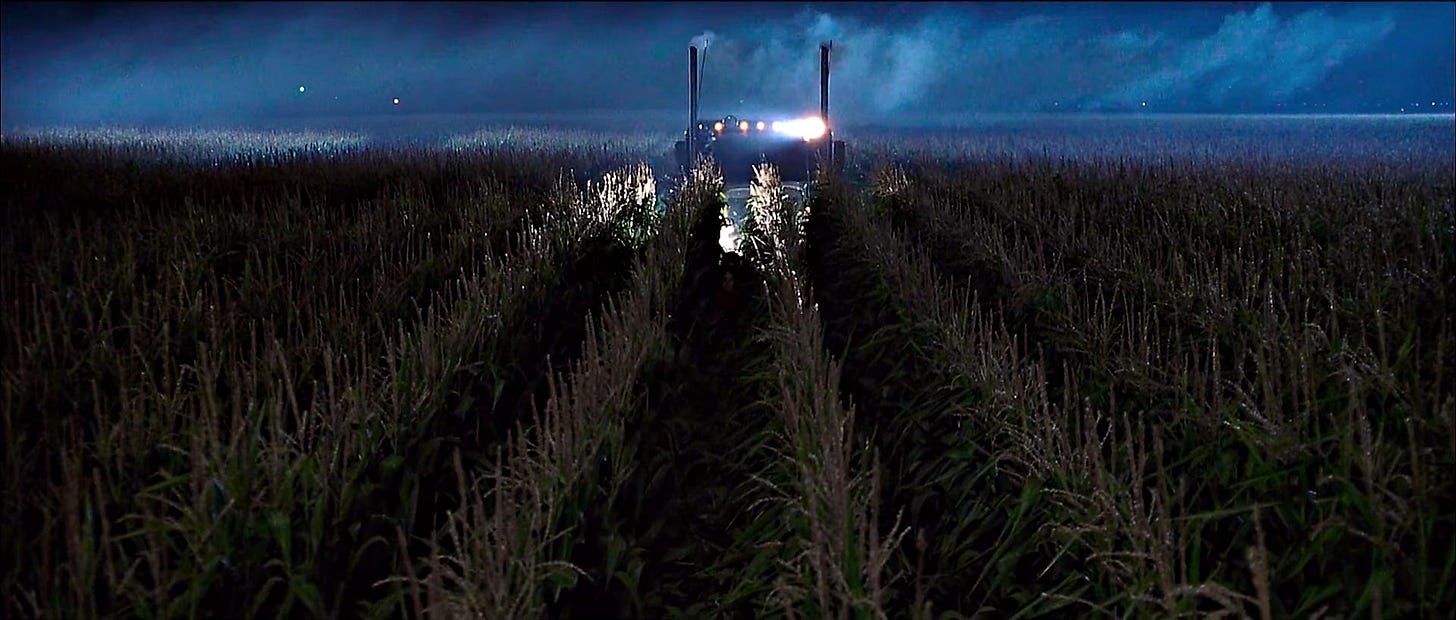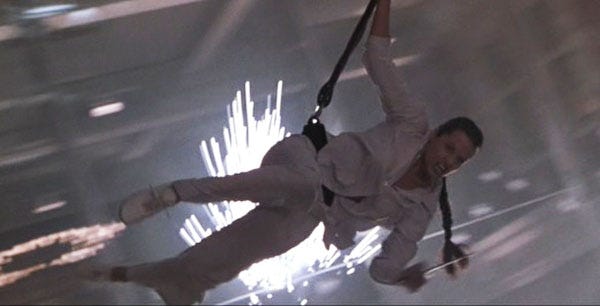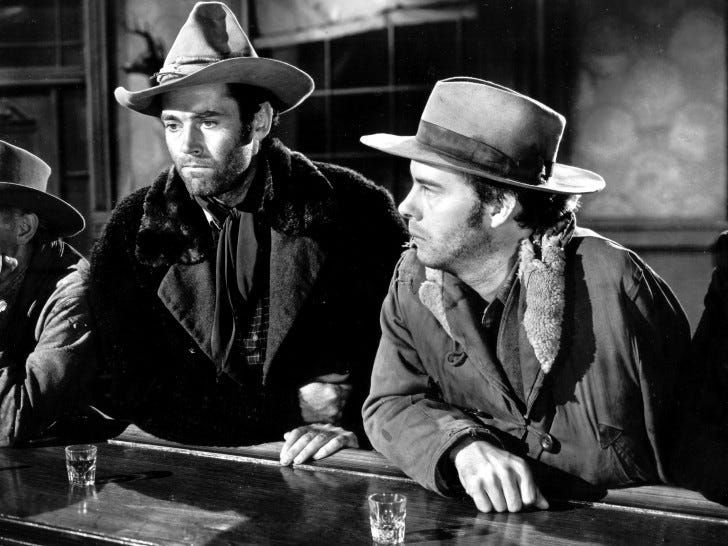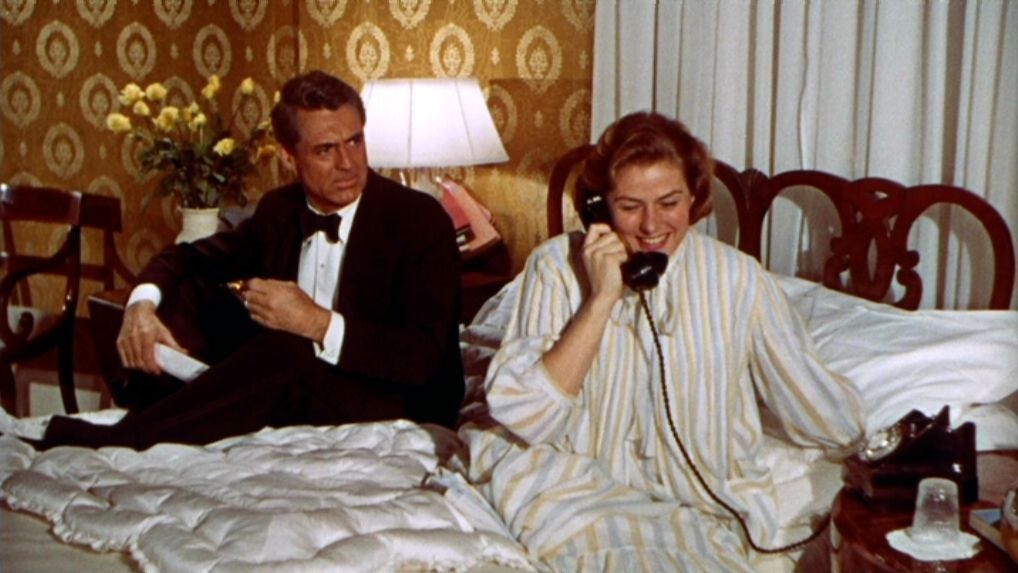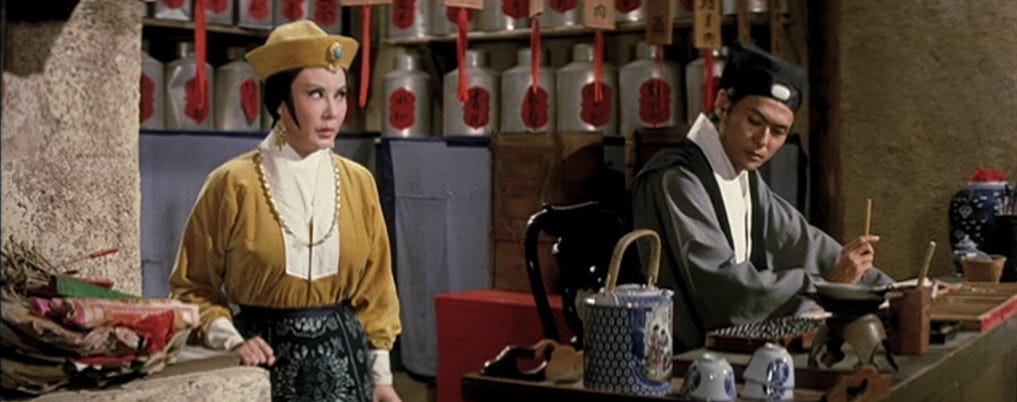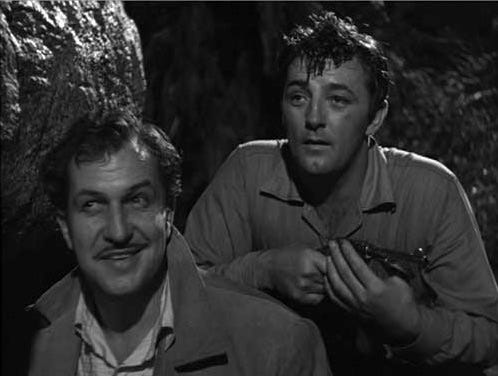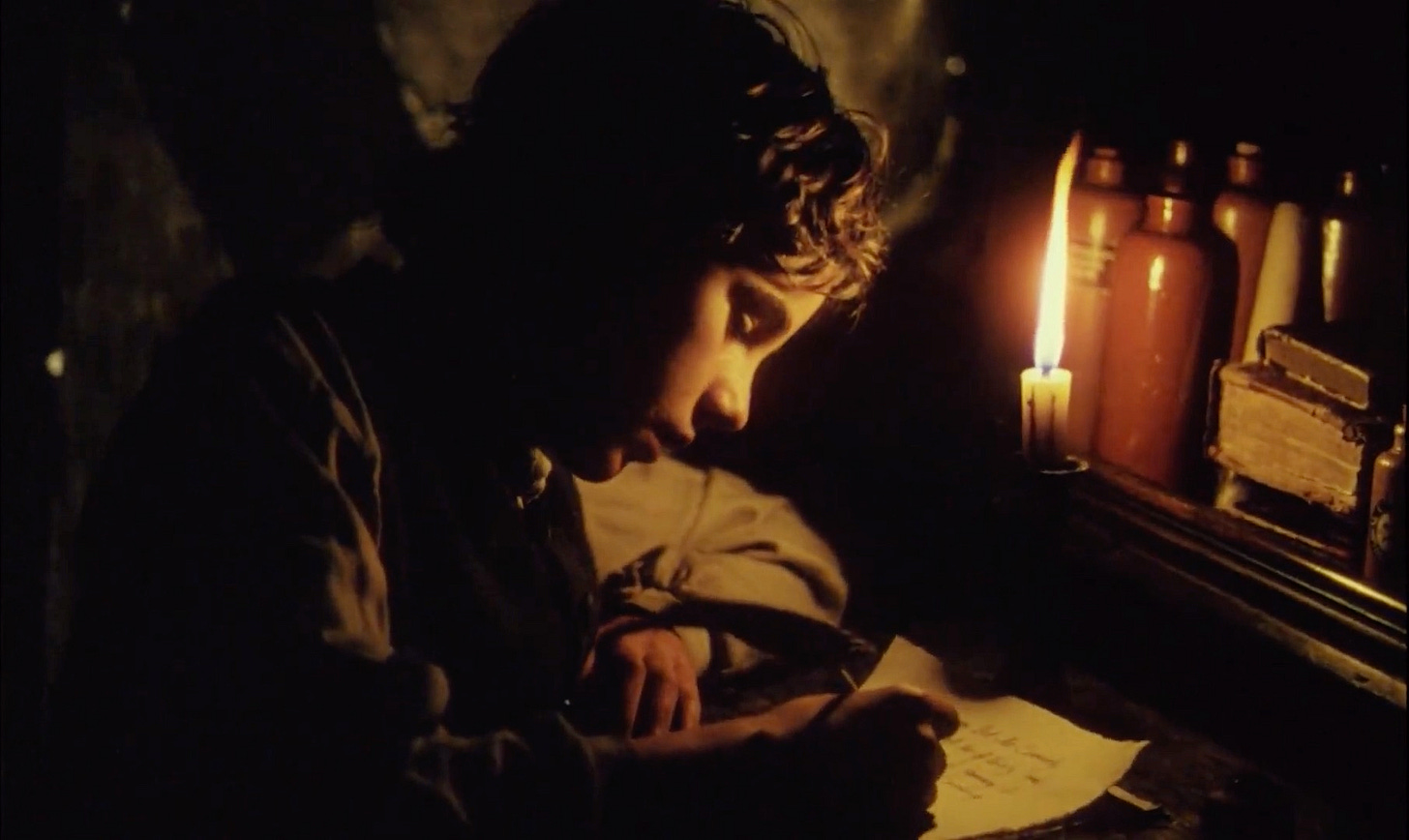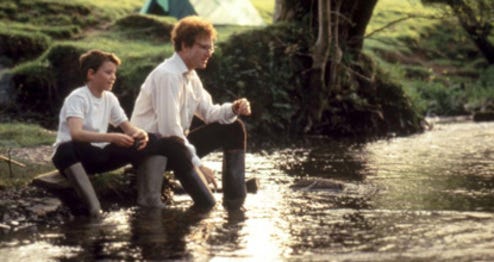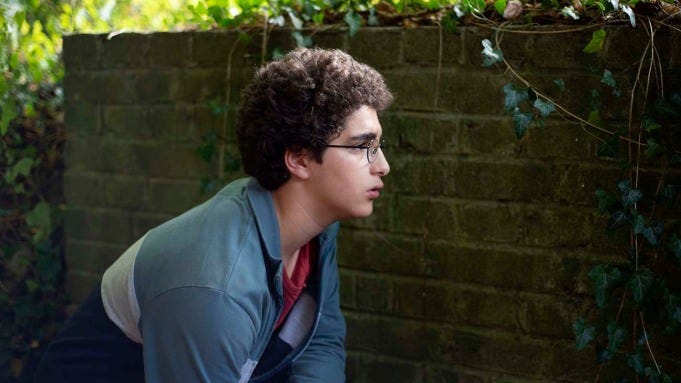Hello! As this post may be too long for some email providers, you may find it best to click through and read on Substack. Thanks for being here.
I saw exactly three new releases last year: Wrath of Man, The Tomorrow War, and No Time to Die. At the rate I’m going with catching up on my to-see list, I probably won’t have a decent 2021 list until early 2023. So, reader, be warned: what follows has nothing to do with films released during the last calendar year, but with everything else I watched for the first time during a now very distant 2021.
For years, my favourite annual list to compile has been this one, the ‘new-to-me’ list which captures in one place the great discoveries and surprises of day-to-day cinephilia. It is this list which tells me the most about myself as a cinephile. Out of a semi-opaque mixture of instinctual and intentional decisions, certain patterns become visible: habits directed towards certain directors, actors, subjects, themes, and historical periods. New loves are welcomed into the fold and old loves, perhaps long neglected, are reconfirmed.
Altogether, these films become the bricks of a cinephilic identity which is always under construction, year after year, film after film. The purpose of structuring them together in a list is, I suspect, precisely that - to make a structure; to incarnate in words a reality which has no flesh. What is that reality? The piercing which takes place between a film and a viewer, that unspoken bond which fumbles for words: I saw and I loved; I saw and I knew; I saw and I beheld. It may begin with affection or with insight, but either road taken in good faith will lead to their mingling in the affectionate insight that is beholding. Beholding what? In all of the diverse ways in which it can be known, simply reality itself. Encountering each of these films in their own particular way constituted an encounter with reality, with something behind and beyond them, and yet so very much of them.
That is why this isn’t a ‘best of’ list, strictly speaking. There are a number of questions which, upon hearing the sound of a new list being uncanned, scamper inexorably to the kitchen: that of objective and subjective values, of the criteria for making critical judgements, of taste, of canons, and so on. These all have their place and the cinephile who begins peering at his own lists will eventually find it necessary to begin asking them, if only to understand the foundations of his own taste and judgement. But for now, it is enough to simply note where the encounters have begun. They begin in that flash, that piercing, that moment which can only be summarized as delight.
What follows is an account of delight taken wherever it was most intensely found. Every title here is a film which grabbed me and refused to let go, during the viewing itself or sometime later, while contemplating its memory. Many of these were indeed great works in the most complete sense: beautiful and fulsome to behold, dazzling in both their wholeness, their unmarred integrity as whole beings, and in the brilliance of their parts. Others were middling or imperfect or even deeply impoverished efforts which nonetheless shone for a moment or two. In doing so, they still gave a great gift - some contact with deeper reality.
By writing about these encounters, I have tried to follow delight back to its den. What is the greater significance of these sightings? What follows are some halting and lurching attempts to answer that question. Come with me, and perhaps we will uncover a thing or two, yet.
The Joy of Poiesis: Part I
Topsy-Turvy (Mike Leigh, 1999)
The most delightful film I saw last year was Mike Leigh’s Topsy-Turvy (1999), an achingly-researched dramatization of the production of Gilbert & Sullivan’s The Mikado in Victorian London. Now, I’m already an easy mark for procedural works about the making of art, but even among the short list of great films in this realm, Leigh’s shines brightly. This is because while the film ably balances its dramatic, historical, political, and philosophical interests, it never loses sight of the central one: the absolute wonder of seeing art being made before one’s eyes.
This profound gift is offered not only through a lavish depiction of the 1885 premiere of The Mikado itself, but much more so through happily extensive scenes which imagine the stumbling and stuttering efforts to write, compose, and rehearse the opera. Here, we see frail men and women inch their way towards the nobility which crowns both a work well made and those who make it. Nothing is left unseen: the fragile contingencies of inspiration, the dead ends, the starting over, as well as the rivalries and recriminations of so many egos tumbling together.
To say that Topsy-Turvy is a successful work about its subject is true, but to leave it there does not do justice to the full breadth of its achievement. What I want to say is this: Yes, it is a generous and expansive window onto the concept of poiesis (of ‘bringing into being’), but its greatness goes much further: to watch it is to experience the ecstasy of poiesis itself in an acutely self-aware and yet modestly realized way. The scenes that come closest to this high wire achievement are those which lean into the steep reality of rehearsing: the starts and stops, the on-the-fly comments, the minute changes to rhythm and intonation, the messiness of getting it right, and the joy of arriving at the destination. There is something deeply uncanny and intoxicating about these scenes, of actors playing at rehearsing, of actors playing actors, striving to reveal an image of recta ratio factibilium (‘right reason about making’) in motion, and us never quite knowing where, for example, the ‘right reason’ of Allan Corduner the actor ends, and that of the character of Sullivan the composer begins. In the beholding of these extraordinary moments, one cannot make a distinction between them - it is all one, and it is glorious. For me, this is the promise of cinema fulfilled, and yet never exhausted.
And then there is also the bit about Mr. Alexander Graham Bell’s new talking device, and what using that might have been like. If the joy of poiesis won't do it, then there is always this…
Perfect Thrillers: Mann and Hitchcock
The Tall Target (Anthony Mann, 1951) / The 39 Steps (Alfred Hitchcock, 1935)
What does the perfection of a thriller entail? For one, it must never stop moving. It can slow down, but not by much. Second, its constant motion permits it to constantly shake up its situation with obstacles and insights organically derived from a new place, or a new face, or perhaps the combination of both. Third, the end is never really in doubt. By that, I do not mean that we already know the particular resolution of the plot, but simply that the hero will eventually reach a literal end, a goal, the telos he or she is running towards, and that the pleasure for us is mostly in the journey. In this sense, taking pleasure in a thriller is very much like taking pleasure in a machine, and its total perfection has everything to do with the perfection of its parts working in exact order.
Is this an airtight description? Not at all; the thriller is a malleable genre with many possibilities. But what I have tried to do above is sketch a definition based on two quite different films which struck a deep chord inside me but whose pleasures are entirely consonant. What are those pleasures? That these films, more than anything, announce themselves as perfect machines of a sort. One is lean and mean; the other is elegant and feather-light; both are exemplars of crisp and frantic momentum, of sudden decisions and tables turning, of the pure pleasure of plot mechanics turning without grind or groan.
In The Tall Target (Anthony Mann, 1951), a detective (Dick Powell) boards Abraham Lincoln’s inauguration-bound train in 1861 in order to ferret out a plot to assassinate the president-elect before he gets to Washington. Anthony Mann is one of the great Hollywood directors whose economy is absolutely pure: what you see feels like exactly what he intended to shoot, with no other options to consider. The pleasure of Mann is the pleasure of pure cause and effect unfolding before you, but what’s more remarkable is how he fulfils the goal of each scene without relegating side characters to the role of pure function; each one leaves a distinctive impression with only a few moments to get to know them, driving home the sense that this ruthless plot is taking place in an actual world.
The thing about finally watching The 39 Steps (Alfred Hitchcock, 1935) for the first time is that one gets that rare thrill of seeing a Platonic original in its pure form. The DNA of the modern action picture, which Hitchcock would perfect for a second time in the 1950s, is everywhere in this. But then, its pleasure is not simply in its excellence itself, but in the joy of seeing different forms coming together into something altogether new. Hitchcock seems to be inventing a new genre before our very eyes, pulling off coups that should not work, achieving an almost impossibly elegant balance between comedy, romance, and mystery. The one thing that remains constant is that it moves, and so we are reduced to the somewhat vague description of the natural response to something which excites by sudden motion; it thrills.
It is so confident in its constant reinvention of itself that it's almost easy to underrate. I would like to linger on this for one further moment, as there is a bit of a contradiction to clear up. It is hard, as a post-millennial viewer, to see The 39 Steps as a thriller in its most essential sense precisely because it is so frothy, buoyant, and funny, even in the midst of very dangerous situations. Many, perhaps most, strict thrillers of our time tend to have more grim designs in mind. How does a film as light-hearted as this really stand up as a thriller?
Some light is shed if we consider that the roots of ‘thrill’ in Middle English (thirlen) have to do with ‘pierce.’ To be thrilled is to be pierced, and it is this very language that some have used to describe the experience of beauty, as an arrow which pierces the heart and opens the eyes. We have already noted that much of a thriller’s inherent pleasure seems to come from the perfection of parts working seamlessly to make a whole system fulfil its purpose, and regardless of Hitchcock’s tone here, that is exactly what we find - gripping mystery, amusing comic episodes, an out-of-nowhere departure into screwball romance, all with their own provincial goals, which pierce with delight over and over. Can such a conglomeration of smaller delights operating without much care for the larger telos really make a whole delight? This is the question which The 39 Steps enthusiastically answers in the affirmative.
Surprises of Late Auteurism: Rohmer and Tavernier
Triple Agent (Eric Rohmer, 2004) / Captain Conan (Bertrand Tavernier, 1996)
The later periods of a director’s career, especially one regarded as an auteur, can often provoke confusion and backlash among his or her devoted followers. When a consensus of value has formed around a body of work which is so consistent in its aims and achievements, it can sometimes obscure the fact that filmmakers remain living and thinking beings who may well desire to do something different from time to time. Sometimes, with a burst of energy, they will leave behind what was previously great and do things no one has asked them to do. I would argue that some of this dynamic can be found in the films of Steven Spielberg since his last masterpiece, Lincoln, a period of activity which seems aimless and puzzling to me.1
The opposite dynamic, which is also common, is that of an auteur hewing so closely to their familiar interests and tricks that followers begin to tire of repetition. The poiesis that first gained a director his following seems to have disappeared while he still carries out the same movements and gestures, making reanimated corpses out of earlier successes. This is a frequent complaint (not mine!) about Terrence Malick since he conquered the world with The Tree of Life; to read his many critics is to be convinced that every film he has made since 2011 has had too much twirling, too many shimmering fields, too many voice overs; too many Malickisms.
In sum: it would seem that the late films of auteurs have a way of testing even the most faithful auteurist follower, whether by innovation or repetition. Peering closer at such films, however, can be extremely fruitful for our understanding of what auteurism really is.
What strikes me most about Triple Agent (Eric Rohmer, 2004) is how effaced it is, even for a Rohmer film. On the one hand, even though it is a movie about spies, it is first and foremost a film of people talking quietly in bourgeois sitting rooms; the cheapest observation to be made is that few things are more quintessentially Rohmerian on a surface level. Our characters enter, move, stand, and sit with the typically efficient elegance that characterizes Rohmer’s mise-en-scene: nothing is signified by such actions, which simply happen. So far, we are on sturdy ground; to the end, Rohmer was André Bazin’s closest conspirator in exploring the logical ends of what film realism really entails - and perhaps taking a cue from John Le Carré, Rohmer understands that the essence of spy craft is deception, which is mostly obtained by careful performance and speech. What seems to be missing, especially for those who most prize Rohmer’s relationship comedies, is any sense of the inner turmoil of characters - especially ones caught up in a web of espionage and, as the title reveals outright, triple crosses.
As I said, late films have a way of testing the most faithful auteurist, and I think such a test awaits even the most ardent Rohmerian with these last films, as the old master seems to be no longer interested in deeper concerns but only with what is merely legible in the scenario he has chosen to share. Instead of hints of inner life, we get text. What kind of text? All kinds: endless information, plot details, historical items, movements in and out of Paris, meetings, plans, plenty of stuff, but not much to give us insight into the people doing all of it. That which lurks underneath - the themes, tics, and formal tells that build an auteurist’s dossier - seems to be gone. For the Rohmerian, it is hard to quell a rising feeling of disappointment.
All of which remains the case until the film’s final, shocking moments, when the house of lies built by the main character collapses with astonishing speed and the work as a whole comes into sharp focus: who can be surprised that a man who deceives his wife, friends, and foreign spymasters may also, above all, be deceiving himself? And suddenly we find ourselves in the most Rohmerian territory possible.
Further reading: Dan Sallitt
From a positive example to a negative: what if you become an auteurist searching in vain for an auteur? My most frustrating project last year involved trying and failing to get into Bertrand Tavernier, one of the more famous second-generation figures of the French New Wave. The project failed because I could not find a way into Tavernier’s essence as an auteur - and yet I still fell in love with Captain Conan (1996), a searing study of a particularly brutal French commando unit and its unhinged and charismatic leader, the titular Conan, near the end of World War I.
After my June 2021 viewing of the film, I wrote a few notes about my general frustrations with Tavernier, or at least with trying to locate him as an auteur:
“Have I finally “gotten” Tavernier? I’ve found my other viewings of him (The Clockmaker of St. Paul, The Judge and the Assassin, A Week’s Vacation) to be both befuddling and mildly tedious. Befuddling in the sense that his visual language is deeply appealing - stately, elegant, purposeful but not insistent, detached in proximity, warm in tonality - but so often in service of scripts which amble from one event to the next without modulation or changes in rhythm, or even a sense of structural play. His earliest works often feel like someone who isn’t actively ignoring or fighting the lessons of the New Wave, but simply slept in and missed all the notifications. These films are far too amiable to militate against anything.
The nature of his writing is not simply a matter of “stuff happens and means nothing; the end” which would characterize a genuinely nihilistic work, but that even where his films seem poised to tilt into nihilism or into any sort of commentary, they instead retreat into the narrative’s surfaces, seemingly disinterested in penetrating any deeper than showing the very basics of causation. A causes B, the end. Repeat. What’s also missing is any sort of hovering presence of the auteur as an unspoken but unmistakable guide to all that is unfolding - a moral and philosophical guide - which students of the Nouvelle Vague have become accustomed to finding in everything. One might even be willing to say that Tavernier is knowingly eliding this, but were we to prove that, it would at least negatively satisfy the desire for an auteurial frame of reference.
Instead, these seem to be some of the most blandly straightforward works of the post-French New Wave period, and even if their simplicity is at first refreshing, eventually it just seems like the underachievement of someone who doesn’t know enough to care that they’re underachieving. Is complacency the right word for films otherwise made with such care? What is the kern of Tavernier’s cinema? I have not found it.
And then here comes Captain Conan to demolish my complaint, though I was still grumbling even up to its ¾ mark or so. I still have no idea how to position Tavernier as an auteur, but I am beginning to get a sense of him as a student, perhaps by osmosis, of the New Wave he famously declined to participate in. Conan, an enormously charismatic and frustrating figure, is nothing less than Antoine Doinel in the most bloodthirsty of contexts. He is a monster, driven by appetite and rage, held down only by loyalty to his fellow monsters, who having fulfilled the state’s purpose as weapons of concerted brutality in wartime now run amuck in peacetime.”
To which I would add (with many months more hindsight): the frustration of Tavernier is indeed that he is focusing on text and cares little for subtext. In a vacuum of meaning, it becomes more tempting as a viewer to insist on finding signs of the filmmaker’s presence, which Tavernier, to my mind, assiduously avoids. Perhaps this is his kern: coming in the wake of the New Wave, he is concerned with making his own way, and the only way to break ranks with such a self-conscious and self-concerned act as the Nouvelle Vague (hello, Godard!) is to go in the opposite direction and efface oneself completely. In many ways, this is exactly what Eric Rohmer did - but, I would hazard, Rohmer filled his self-effacing films with such a fidelity to the richness of their contents that his very modesty became an unmistakable auteurial signature!
Tavernier, from what I can see, has not been so successful, partly because his content simply isn’t that interesting (to me, at least). I think this is the main reason why I responded so strongly to Captain Conan, which (like some other Tavernier films) is based on a novel and thus cannot entirely escape the trap of subtext. Whether through fidelity to the book or through some sort of attrition, the denouement of this film, which takes place well after the war has ended and its lions have begun their descent into ignominy, is deeply moving in a very conventional and novelistic way: after hours of bellowing comes a confession of frailty which in one instant strikes every note - elegiac, nostalgic, tragic, and utterly human. I found this moment completely overwhelming, revealing the rambling and frustrating essence of earlier passages of the film with a heartbreaking clarity. In the end, it really is all about the end.
The William Wyler Hour
Detective Story (William Wyler, 1951) / The Desperate Hours (William Wyler, 1955)
One of the highlights of my year was finally reading André Bazin’s famous essay “William Wyler, the Jansenist of Directing,” initially published in 1948 (Bazin made new footnotes for it before his death in 1958). In the essay, Bazin compares Wyler to other notable directors of the period by noting that Wyler, unlike John Ford or Fritz Lang, has no obvious motifs or mannerisms that signify his body of work as the work of the same director. Instead:
“There is a John Ford style and a John Ford manner. Wyler has only a style. That is why he is proof against parody, even of himself. Imitation of Wyler by other directors would not pay off, because Wyler’s style cannot be defined by any precise form, any lighting design, any particular camera angle. The only way to imitate Wyler would be to espouse the kind of directing ethic to be found in its purest form in The Best Years of Our Lives. Wyler cannot have imitators, only disciples.”2 (emphasis mine)
A couple of lines later, Bazin suggests a governing principle of this directing ethic: “The whole tendency of the mise en scène is to efface itself.” Further, this effacement is not only about what is in the frame, but extends to choosing camera optics (lenses, distances, angles, and focal lengths) which do not unduly distort or distract. For Bazin, Wyler’s “asceticism” as a director functions to bring the viewer close to the material so that he may see clearly and choose what action or drama to follow “of his own will.” The viewer is respected as a participant free to see without coercion or browbeating. In sum, the integral achievement of the typical Wyler picture is that it offers a field of vision onto its subjects which is calm, mature, clear, and freeing.
This clarity of vision is plainly on display in the two Wyler films I saw last year, Detective Story and The Desperate Hours. Despite the fact that they are both working from somewhat mediocre source material, these films are intensely pleasurable examples of Wyler at the height of his powers. Both are based on plays and largely limited to one main location; both employ deep focus compositions which allow the viewer freedom to roam and take in every detail. Because of these two features - a limited setting and deep focus - the pleasure of each film grows as familiarity increases with the surroundings.
In Detective Story (1951), the greatest pleasures are to be found in the dynamic staging of the open-concept detective office, which is teeming with multiple stories running at once. I’m not sure how to describe this except that right from the first frame it registers as a place of absolute potency and unity. There is a deep sense that life is unfolding without any concern for the main plot - Kirk Douglas being a zealot - and every time we return from his private dramas into this staging area, it underscores a division between the setting and the story being told. Background characters bubble into the foreground at moments which, we might think, somehow serves the whole - and sometimes this is clearly in service of clarifying a detail or character beat - but not every outburst is in service of Douglas’s own plot, per se. Life is going on and for many of the unhappy suspects and witnesses floating around the office, their drama consists entirely in being on display, of having their grief and shame be inescapably public.
And this is really where Wyler’s genius for space comes to the fore. The central tragedy of Douglas’s puritanical detective, which is conducted in private spaces - closed offices, side rooms, rooftops, closets - eventually becomes one more public tragedy on the main stage; one more piece of the whole mosaic which was previously only a background to the story which really mattered. That it achieves this shift without being necessarily nihilistic speaks, I think, to Wyler’s careful humanism: every life matters; every heartbreak is real. What seemed to be only accidental intrusions on the real story are precisely what lay the foundation for accepting Douglas’s fate in all of its sorrow and, in some way, its mercy.
The Desperate Hours (1955) zeroes in on one situation from beginning to end: a trio of escaped convicts (led by Humphrey Bogart) takes a well-to-do suburban family hostage in their own home. This was Wyler’s first film shot in a widescreen ratio and the result of expanding his deep focus approach to a wider frame is absolutely electrifying - almost like seeing for the first time. With this approach of utter clarity, the banality of an upscale suburban house suddenly becomes fascinating, a place charged with details which seem insignificant at first, but all have a part to play. Once the killers show up, the extreme width of our vantage becomes a crucial aspect of suspense - every bit of distance between criminal and victim becomes important and our expanded field of view provides that much more awareness of the danger lurking in each interaction between hostage and captor. It is this aspect of the drama which makes the most sense of Wyler’s visual scheme: to see as wide and far as possible is the single greatest purpose of a surveillance camera, and here that principle of hyper-awareness becomes the vehicle for initiating viewers into the anxiety of being a hostage. But, aside from these purely functional uses for a technical innovation, it is the early domestic scenes which will stay with me: a family at breakfast, rendered in total clarity and repose. What a gift it is, simply to see.
Can’t Say No to a Good Hash: Truffaut and Lumet
Love on the Run (François Truffaut, 1979) / Night Falls on Manhattan (Sidney Lumet, 1996)
Early last spring, I watched all of François Truffaut’s Adventures of Antoine Doinel films in order, revisiting The 400 Blows and continuing on to first-time viewings of its sequels: the short Antoine and Colette (1962), Stolen Kisses (1968), Bed and Board (1970), and Love on the Run (1979). Each chapter continues the picaresque life story of irretrievable boy-man Antoine Doinel (Jean-Pierre Léaud) as he drifts further and further into inescapable adulthood. Upon finishing the series, I was stunned to find that the somewhat ill-reputed finale ended up as my favourite of the bunch.
Why was I stunned? Because Love on the Run (1979), besides being a mostly mercenary entry in François Truffaut’s filmography (he needed a reliable profit-maker after the failure of 1978’s The Green Room), is well-known for relying heavily on flashbacks from the earlier films in the cycle. A healthy percentage of its running time is given over to reliving moments of Doinel’s life which have already flown past our eyes - and if you’ve been watching these films in close succession, you may be a bit concerned about how much is just a pointless rehash and how much is new.
And that’s where the surprise lies: it’s a rehash, yes, but a deeply self-aware, gentle, and bittersweet second look. I found it elegant and overwhelming; in its best moments, it achieves the kind of grandly compressed ambitions of later lifetime chronicles like Boyhood or The Tree of Life, but it should be noted that narrative really isn’t the goal here. Instead, Truffaut takes full advantage of cinema as an edited form to give us not a story so much as a poetic reassessment of the Doinel legend, one conducted by everyone involved: Antoine himself, the lovers and friends and former villains who cross his path, and by us, the viewers who have access to a seemingly reliable command of his history unfolding in front of us. In fact, up until this last entry I would have considered the Doinel cycle after Antoine and Colette to be an amusing but otherwise unremarkable experiment; here, it finds its end in something closer to wisdom.
Suspicions of rehashing also daunt the later work of Sidney Lumet. How many times can he profitably return to the well of police, legal, and political corruption in New York City before it runs dry? From what I can tell, The Verdict (1982) is more or less regarded as his last major work in this oeuvre (following Serpico and Prince of the City); the more generous opinion might make room for Q&A (1990), a return to gritty Serpico-style police proceduralism. And then we have Night Falls on Manhattan (1996), a quintessential Late Film if ever there was one. Retreading every theme from each of those films, plotted and acted with typical Lumetian intensity and efficiency, on paper this easily reads as a ‘greatest hits’ compilation: instead of only police corruption (Serpico, Q&A), we get that plus a crusading lawyer (The Verdict), plus a proto-Wire cross-section of the city’s criminal and political structures (Prince of the City).
Why, then, did I find it so striking? For one, it’s as sharp an ensemble as any in Lumet’s career, with Andy Garcia, Ian Holm, James Gandolfini, and many others bringing their A-games; for another, it moves with as much vitality as any of its predecessors and manages to weave all of their concerns into one integral whole without feeling patchy or inorganic. What ultimately casts this for me as Lumet’s last truly great work is the way it carries itself, with a weary and a bruised wisdom that is nearly drained, but not yet hopeless. It is recognizably the work of an aged man who has seen too much pain and has no answers, but who also refuses to plunge into nihilism. It may not be uplifting, per se, but it is deeply knowing - and like many forgotten late films, perhaps it arrived too early for its real audience.
Curiosities of 2001
The Last Castle (2001, Rod Lurie) / Joy Ride (2001, John Dahl) / Lara Croft: Tomb Raider (2001, Simon West)
Here is the trap of Amazon Prime: having plumbed the catalogues of my adolescence, they insist on licensing a number of titles which I was too young to see or wrote off at the time as worthless. Twenty years later, here I am giving them a look. Why bother now? It always begins with curiosity about the films themselves - could Tomb Raider be that bad? - but the more I watched, the more I became interested in the age which produced them. Three films in particular struck me, first for their own peculiar merits, and then by their utter guilelessness as artifacts of a Hollywood which no longer exists.
Watching these films, we will never be able to not see 9/11 lurking in the wings. This knowledge has a way of heightening certain qualities: these are films which seem impossibly naive, exuberant, and carefree. The genre conventions they rely on are firm, and they are untroubled by real-world politics. I think these are worth holding up for study precisely because they were not particularly noteworthy in their own time, and have since been mostly forgotten. Other 2001 fare, like The Fellowship of the Ring, immediately found a place in the traumatized post-9/11 order. These films, completed before the towers fell, were left behind.
The Last Castle (Rod Lurie) is the archetypal “film they don’t make anymore:” a mid-budget drama for adults with a deep bench of old and new Hollywood male talent swinging for the fences. For that reason alone, it’s easy to overrate. Thankfully, it bears a concept which is patently ridiculous on paper: an honourable general (Robert Redford) is sent to a U.S. military prison for disobedience, where he matter-of-factly raises the ire of its psychotic warden (James Gandolfini), a deranged martinet who crushes the spirits of the men under his watch. A war of wills and a conspiracy to take over the prison ensues. The film’s great advantage is that it does this scenario the honour of taking it extremely seriously, with the requisite number of character-building bits highlighting the necessity of honour, virtue, and brotherhood in the life of man.
All of this is sturdily if not exceptionally staged, but for two elements. First, there is Gandolfini’s humane, deeply wounded interpretation of a stock villain type, the post-Shawshank psycho-warden, which is in many ways more interesting and sympathetic than Redford’s stoic heroism. Second, there is Lurie’s command of the prison yard as a space naturally suited to cinematic storytelling. From the vantage of Gandolfini’s office, with its improbably huge window onto the yard, it becomes necessary to piece together bits of information from the silent actions of the inmates below. We, and the warden, watch through a Vistavision-like pane of glass, ‘zooming in’ with binoculars when needed, getting hints of plans, trying and failing to put causes and effects together, and it is at these moments when one feels the electricity of a director breathing ingenuity into a tired genre.
Nasty, clever, but not clever enough: Joy Ride (John Dahl) is a typical Gen X remodulation of tropes both near (90’s teen romance) and far (70’s road thriller). It’s about college kids who play a dirty prank on a trucker at a motel, and end up hunted by him across the Midwest. It’s not trying to be Scream and so it never goes all the way into a full or half-hearted meta-treatment of its mashups, but being a quasi-horror work of its time it cannot escape Scream’s shadow and accounts for it by casting Steve Zahn in full motormouth mode.
Joy Ride is both rickety and extravagant, making it a naturally appealing object for cinephilic reflection. In-car scenes are clearly filmed with process shots in a studio, lending it the air of a late 40’s B-noir cheapie that is only a few minutes away from running out of money. But then, once the film is out and stretching its legs, director John Dahl indulges in surrealist flourishes: the trucker’s first attack, heard through a motel wall, takes place over a long take contemplating the most beautifully mercurial painting to ever hang in a roadside inn. The greatest praise, however, must be reserved for the film’s central set-piece: an evil big rig hunting its victims in a corn field. Switching its cues from Duel to Jaws to The Lost World, with the rig’s exhaust pipes gliding above the corn like fins, it’s a deliriously madcap, clumsy, and strangely innocent coup de grace.
What Joy Ride lacks, and what marks it forever as a last gasp of a different era, is a pervading sense of naïveté and gentleness. Despite centring on an evil truck driver who rips jaws off of his victims, the proceedings have an air of safety: even with innocent bystanders getting caught in harm’s way, there is never much doubt that the central trio will make it through alive; it’s a thriller, not a slasher. What I can only interpret as ‘the enduring optimism of the 1990s’ takes the edge off any sense of danger here and I find it all the more endearing for it. Actual dread would return to this sort of picture soon enough.
Lara Croft: Tomb Raider (Simon West) is not a good film, but neither is it a particularly bad one. Let me be the first to say that the temptation to recover old mediocrities for the sake of contrarianism is an ever-present one, and I recognize that including this on an end-of-year list might constitute a gesture towards ‘recovery.’ I will try to be as clear as possible, then: Tomb Raider ‘01 is as bracingly mediocre now as it was in 2001, and no amount of anti-Disney/Marvel bitterness over the state of modern blockbusters can change that fact.
What hindsight does allow for, though, is a better posture for appreciating the tension between Angelina Jolie’s deeply intelligent performance and everything she is given to work with and around. It’s not a case of an actress rejecting or subverting her assigned material, given that the material is so insubstantial, nor one of her embracing it without qualms. What Jolie does here is more complex and subtle. Her read of the character of Lara Croft is one of constant bemusement more than anything else and it's a strangely endearing star turn in a film that is too stupid to do anything constructive with it. It strikes me as the work of someone who knows they are above the material but has enough humility to condescend to it without contempt. Perhaps some credit is also owed to the shaggy plot which follows the usual globe-trotting schema, but not so breathlessly that it can’t enjoy each stop at a slightly less hectic pace than is typical of these sorts of films. Come to think of it, it’s a pace appropriately representative of the summer of 2001, before everything changed.
And the Rest…
Let us dispense with themes and begin our final descent with some quick notes on some one-offs:
The Ox-Bow Incident (William A. Wellman, 1943) is a true gut punch of a film; one of the most memorable moral fables of its time. Brisk, gorgeously shot, and so brutally honest about fallen human nature that it’s still mildly shocking this passed the censors in 1943. Come for Henry Fonda’s laconic cynicism, stay for Dana Andrews’s show-stopping nobility.
Indiscreet (Stanley Donen, 1958) reunites Notorious pair Ingrid Bergman and Cary Grant in an elegant waltz of a farce. On the page, it’s feather-light screwball material; on screen, the age of its leads grants this romance a certain mature winsomeness and depth. The aura of desire they project isn’t simply one of lust or love, but full of unspoken things - roads not taken, regrets still rattling. On top of this palpable air of yearning, Donen makes some head-scratching decisions: most of the film takes place on extremely stagey sets which are functional at best. He puts both camera and actors into these spaces in the most blandly functional ways, and blasts every light at everything in the room. The effect is bizarrely austere, even inert - almost like the goal was to make a comic version of Dreyer’s Gertrud.3
All of this comes together in the second half, when Bergman’s character, a famous stage actress, puts together a series of staged scenarios in her apartment to draw out Grant from his intransigent lying bachelor ways. This section is truly remarkable and rewards our close attention to the the space as a stage itself, with Bergman giving a role-within-the-role performance for the ages - for my money, one of her most textured and richly modulated offerings, period.
There are few things more mesmerizing than a master director milking a single location for all of its potential. King Hu always has tremendous action set-pieces, especially in taverns, but The Fate of Lee Khan (1973) takes it to another level, building intrigue and suspense at every step without a single wasted moment. As with all of Hu’s films, the colours are exquisite.
The most fun I had last year was with His Kind of Woman (1951), a completely insane work. It’s insanity is largely due to the meddling of producer Howard Hughes, who changed directors from John Farrow to Richard Brooks near the end of production - but what is surprising is not that they finished the film at all, but that what resulted has the makings of a genuinely coherent cult classic.
It’s an ostensible noir pot-boiler which immediately tosses the pot and settles into a laconic proto-007 vacation resort thriller. The first half of this is pure hangout cinema with a bit of intrigue, as everyman Robert Mitchum agreeably ambles from one minor distraction to another: helping out other resort guests, trading barbs with lounge singer Jane Russell and doing his best to keep an eye on the actual plot, which involves a plan to smuggle a crime lord into the U.S. by trading faces with Mitchum. Then everything hits the fan in the second half: gun battles, yacht sieges, and Vincent Price taking over the show with the most unashamedly madcap side role this side of Airplane!. That this section is just a huge riot is due to Hughes aforementioned messmaking, but John Farrow’s loss is our gain - rarely has production-mangling chaos been so profitable for amusement, in the end.
A work of threadbare historical realism, Black Jack (Ken Loach, 1979) is a gem as roughly-hewn as the typically impenetrable Loachian accents which populate its environs. In 1750s England, a boy finds himself kidnapped by a presumed-dead French convict known as Black Jack; together, they fall in with a carnival troupe making their way from town to town. There, the boy falls in love with a young blind girl, and their innocent romance goes on to form the beating heart of the film.
A rather slow-moving road movie, content to amble into and out of various plots of dubious clarity, the pleasures of this largely stem from Loach’s attention to detail and texture. Like Rohmer’s Perceval le Gallois (1978) this is one of the rare historical works that feels like it could have been made in the time it is set in. Ill-placed mics, mumbled line readings, grainy 16mm, ultra-naturalistic lighting conceits (a Menges speciality); everything about this is resolutely unconcerned with standard metrics of production value and narrative economy, which leaves the gripping final act - a rather left-field, race-against-time rescue mission - all the more surprising and touching.
And speaking of Chris Menges: not even thirty years old, Second Best (1994) is one of a handful of seemingly already-forgotten films from his second career as a director. William Hurt stars as a single, forty-something Welshman who decides to adopt a troubled boy from the foster system. This is very straightforward, sensitive, and heartfelt father-and-son stuff, with a welcome emphasis on the complexity of emotional trauma. I would love to see this get a proper restoration.
The Joy of Poiesis: Part II
Young Ahmed (Jean-Pierre & Luc Dardenne, 2019)
Finally finally, to close out with a thought on one more ending, courtesy of Young Ahmed. I cannot do justice to the electrifying nature of the film’s final moments, which have maybe grown into my favourite Dardenne ending ever. I cannot really articulate what it is that moves me, but I will take a crack at it.
Up until the last seconds of this film, I had somewhat critically filed it away as one more ‘typical’ Dardenne picture - an immersive, hand-held chronicle of a working class or marginalized young person in desperate straits (in this case a young Muslim boy out to murder his teacher for apostasy). On top of this familiarity there is the well-established Dardenne motif of these characters undergoing profound and sudden reversals, and in the moments leading up to the end of Young Ahmed, it is tempting to expect such a shift with a jaded eye.
Why a ‘jaded’ eye? Because auteurism in its most curdled forms has a way of dulling one’s eyes towards the unique and irreplaceable being of a new work, sometimes to the point of assuming that the fundamental reason for its coming-into-being is to express the authorial presence of the filmmaker. Fundamental decisions of narrative or character are misread as impositions of a filmmaker’s will - not to find the proper shape of this story or this character, but to express directorial personality in and of itself.
I think something like this has happened with the general critical reception of new Dardenne works. We think we already know what we are getting. And this is somewhat true; these films hang together as birds of a feather. But where this assumption is allowed to reign supreme, there is the risk of missing what is really happening. For me, the ending of Young Ahmed - in which (spoilers) Ahmed, while making a second attempt on his teacher’s life, falls from her roof, breaks his back, and as his quarry runs out to see what has happened, suddenly and inexplicably repents - jolted me out of this critical complacency.
It is shocking in its violence and in its mundanity - he simply slipped; it is shocking in its poetic meaning - now, finally, after having firmly established his intransigence, he relents. It is shocking that the film cuts to black as soon as he utters the word of repentance - there is no lingering or editorializing, only a brief moment to register that it happened. What is not shocking is that this happened in a Dardenne picture. In fact, it is the most Dardenne ending ever: a sudden, inexplicable reversal of heart whose causality cannot be traced to a visible source. How does the fullness of this moment break through the jaded vision of the auteurist, as it did through mine?
I think it has to do with where we started our reflections: it has to do with poiesis. To speak of this ending as ‘typical’ of the Dardennes is to admit that they, as a rule, ‘do’ endings like this. The jaded view of this tendency is to treat it like they are casting from a mould; that their bringing-into-being of this work is, in some sense, circumventing the full process of bringing a genuine work of art into being. What is being made is still a work of art in some sense, but not a true original; it isn’t new, and thus, it isn’t worthy of our awe. To hold this view is to assume that the end which the Dardennes had in mind was simply to do ‘the thing they always do.’
The ending of Young Ahmed jolts precisely because it flows out of every ‘typical’ decision the Dardennes ‘always do’ in making the film - there is nothing here, formally or narratively, that departs from their playbook - and yet it still stands independently as the only right choice to end this story; it lands with absolute certainty and announces the film as a totally complete work. It’s utter originality, which is as much a matter of its formal realization as its content, is as singular and sharp as the tip of a lance, and what seemed to be ‘typical’ mechanics which got us to this point now reveal themselves as utterly necessary and singular operations. And this is where the heart of the Dardennes’ poietic genius begins to become visible: one is left with the sense that every ending they craft is utterly original, because it springs out of the absolutely unique soil of each protagonist and the choices they make.
Every Dardenne picture is like this: they show without blinking how character choices become causes and eventually these causes reach a threshold of change. What makes this so uniquely theirs in contemporary cinema is that their formal approach is designed entirely to expedite the documentation of these choices - no commentary or subtext, no sentimentalizing, just pure seeing and following each subject on their way. When these characters reach a point of no return, of becoming something else than what they were, the thought of another version of the film which does not arrive in the same place becomes unthinkable. Were the film to proceed and end in any other way, it would be broken.
What am I trying to grapple at here? Simply that the truth of a film’s coming-into-being, which takes time for a viewer to apprehend, can never be known absolutely until the end. It is the simplest thing that can be said about watching a film, and yet it so often has to fight with the crust of expectation or prejudice which forms at any given point earlier in the film. Somehow, the final seconds of an ending can completely transform what came before; the poietic work is never done until it is done, and not a second earlier. To be a critical viewer in the fullest sense - to seek the decisions, the causes behind something - is to be given a window onto the intricacies of poiesis, something which words ultimately cannot describe. All I am left with is wonder at the gift of this film, of its being, of its coming-into-being, and of two brothers who make in a way that is so uniquely their own that it lays bare the very nature of making itself.
My films of 2021:
Topsy-Turvy (Mike Leigh, 1999)
Anatomy of a Murder (Otto Preminger, 1959)
Captain Conan (Bertrand Tavernier, 1996)
The 39 Steps (Alfred Hitchcock, 1936)
The Tall Target (Anthony Mann, 1951)
The Desperate Hours (William Wyler, 1955)
Indiscreet (Stanley Donen, 1958)
The Spy Who Came in From the Cold (Martin Ritt, 1965)
Home From the Hill (Vincente Minnelli, 1960)
Black Jack (Ken Loach, 1979)
The Fate of Lee Khan (King Hu, 1973)
Triple Agent (Eric Rohmer, 2004)
Night Falls on Manhattan (Sidney Lumet, 1996)
Love on the Run (François Truffaut, 1979)
Young Ahmed (Jean-Pierre & Luc Dardenne, 2019)
His Kind of Woman (John Farrow, 1951)
Decision at Sundown (Budd Boetticher, 1957)
Detective Story (William Wyler, 1951)
West Side Story (Robert Wise / Jerome Robbins, 1961)
The Long Goodbye (Robert Altman, 1973)
The Ox-Bow Incident (William A. Wellman, 1943)
Second Best (Chris Menges, 1994)
Joan of Arc (Bruno Dumont, 2019)
The Last Castle (Rod Lurie, 2001)
Lara Croft: Tomb Raider (Simon West, 2001)
Joy Ride (John Dahl, 2001)
Thanks for reading.
No, I have not yet seen West Side Story!
André Bazin “William Wyler, or the Jansenist of Directing” in Bazin At Work: Major Essays & Reviews From the Forties & Fifties, ed. Bert Cardullo (Routledge, New York, 1997) p. 2
For the record: I do not believe Gertrud is ‘inert;’ far from it, but I do believe it is easily misinterpreted as such.

